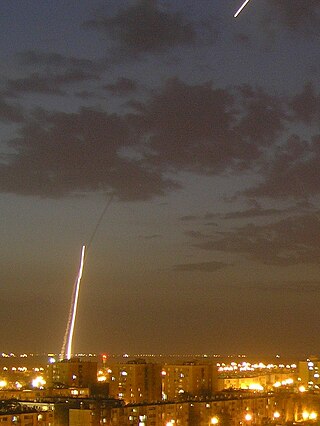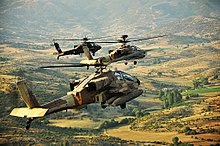Note: The death toll quoted here is just the sum of the listings. There may be many omissions from the list. The human rights organisation B'Tselem has complied statistics of about 600 deaths during 2003 in the occupied territories alone.
This page is a partial listing of incidents of violence in the Israeli-Palestinian conflict in 2004.

The Popular Resistance Committees is a coalition of a number of armed Palestinian groups opposed to what they regard as the conciliatory approach of the Palestinian Authority and Fatah towards Israel.
In 2004, the Israeli Defense Forces launched Operation "Days of Penitence", otherwise known as Operation "Days of Repentance" in the northern Gaza Strip. The operation lasted between 29 September and 16 October 2004. About 130 Palestinians, and 1 Israeli were killed.
This page is a partial listing of incidents of violence in the Israeli-Palestinian conflict in 2005.

The 2006 Gaza–Israel conflict, known in Israel as Operation Summer Rains, was a series of battles between Palestinian militants and the Israel Defense Forces (IDF) during summer 2006, prompted by the capture of Israeli soldier Gilad Shalit by Palestinian militants on 25 June 2006. Large-scale conventional warfare occurred in the Gaza Strip, starting on 28 June 2006, which was the first major ground operation in the Gaza Strip since Israel's unilateral disengagement plan was implemented between August and September 2005.
This is the Timeline of the Israeli–Palestinian conflict in 2007.

In 2008, Israel sought to halt the rocket and mortar fire from Gaza that killed four Israeli civilians that year and caused widespread trauma and disruption of life in Israeli towns and villages close to the Gaza border. In addition, Israel insisted that any deal include an end to Hamas's military buildup in Gaza, and movement toward the release of Corporal Gilad Shalit. Hamas wanted an end to the frequent Israeli military strikes and incursions into Gaza, and an easing of the economic blockade that Israel has imposed since Hamas took over the area in 2007.
Events in the year 2006 in Israel.
Events in the year 2004 in Israel.
Events in the year 2004 in the Palestinian territories.

The 2006 Gaza cross-border raid was an armed incursion carried out by seven or eight Gazan Palestinian militants on 25 June 2006 who attacked Israel Defense Forces (IDF) positions near the Kerem Shalom Crossing through an attack tunnel. In the attack, two IDF soldiers and two Palestinian militants were killed, four IDF soldiers were wounded, one of whom was Gilad Shalit, who was captured and taken to the Gaza Strip.

In November 2012, the Israel Defense Forces (IDF) launched Operation Pillar of Defense, which was an eight-day campaign in the Hamas-governed Gaza Strip, beginning on 14 November 2012 with the killing of Ahmed Jabari, chief of the Gaza military wing of Hamas, by an Israeli airstrike.

Operation Golden Hand was an IDF operation in cooperation with the Shin Bet and Yamam for the rescue of two hostages who were kidnapped to Rafah during the Nir Yitzhak attack on 7 October, 2023. The operation commenced on February 12, 2024, at 1:49 AM during combat in the Gaza Strip during the Israel–Hamas war, and ended successfully with the rescue of the hostages, along with a soldier who was lightly injured during the operation. The coordinated early morning airstrikes that were used as cover for the operation reportedly caused the deaths of at least 94 Palestinians according to the Gaza Health Ministry, which does not distinguish between military and civilian casualties.







